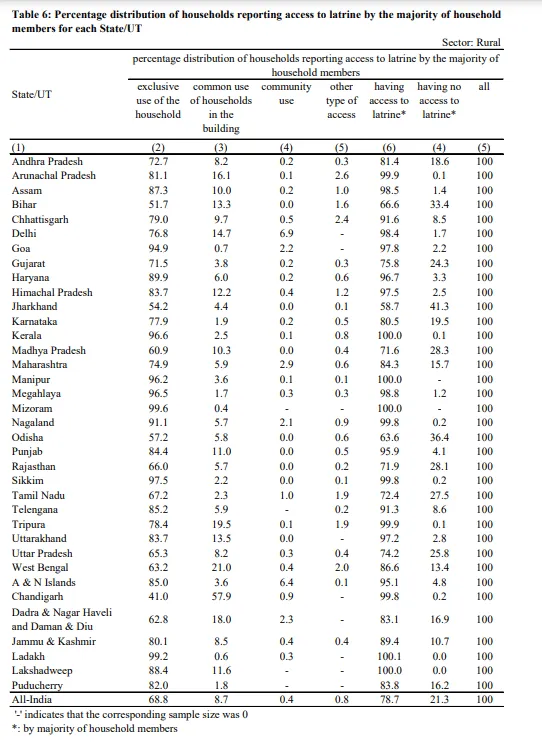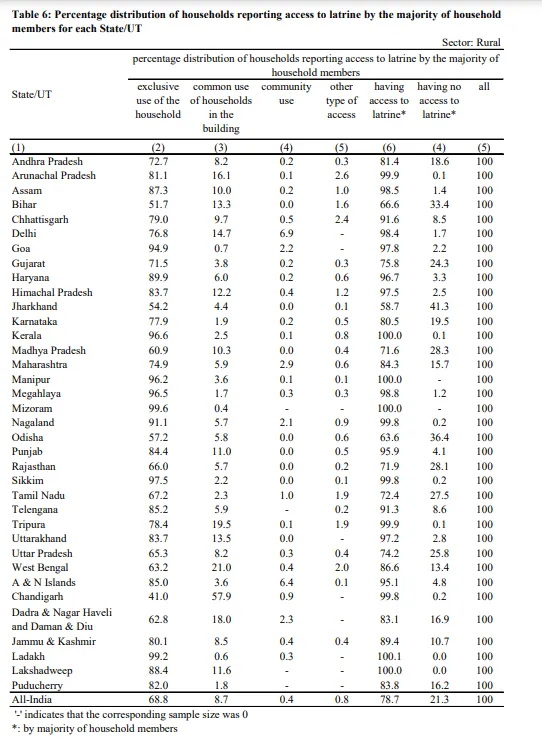As per the Multiple Indicator Survey conducted by the Ministry of Statistics and Programme Implementation, more than 21% of rural households in India do not have access to any type of toilet facility, including exclusive household latrines, communal facilities, or community toilets.
State-wsie data
The survey revealed that Jharkhand has the highest percentage of households without toilet access at 41.3%, followed by Odisha at 36.4%, Bihar at 33.4%, Madhya Pradesh at 28.3%, and Rajasthan at 28.1%.

The Bharatiya Janata Party-led Central government’s claim of achieving open defecation-free (ODF) status in rural India has been challenged by the Ministry of Statistics and Programme Implementation’s Multiple Indicator Survey, which is the fourth study in the last five years to do so.
According to The Hindu, the government’s previous claims on ODF status were also challenged by surveys such as the National Statistical Office survey from October 2018, the National Annual Rural Sanitation Survey of 2019-20, and the National Family Health Survey-5 of 2019-21.
Surveys challenge India’s open defecation-free claim
The latest Multiple Indicator Survey revealed that a majority of members in 21.3% of rural households in India did not have access to any type of toilet facility between January 2020 and August 2021. This marks the fourth survey in the last five years to challenge the government’s claim that all Indian villages are open defecation-free (ODF).
To address these challenges, the government launched Swachh Bharat Gramin Phase-II, which aimed to expand toilet coverage in schools/Anganwadi and provide solid/liquid sanitation facilities in all villages, including waste management systems.

However, only 8% of villages in India had achieved ODF-Plus status by April 1, 2022, and there are still significant gaps in access to toilets and sanitation facilities across the country.
While the Swachh Survekshan Rural Survey conducted between December 2021 and April 2022 reported an average of 95% of households with access to toilets across India, this is in stark contrast to the MIS survey data conducted six months earlier.
Therefore, ongoing efforts to track progress and address gaps in sanitation access are crucial for promoting sanitation and improving public health outcomes in India, particularly in rural areas.
Odisha tops list for lack of urban toilet access in India
According to the Multiple Indicator Survey conducted by the Ministry of Statistics and Programme Implementation, only 2.9% of urban households in India reported having no access to any kind of toilet.
However, disparities exist, with Odisha reporting the highest number of households without toilet access at 19.1%. Jharkhand, Bihar, Madhya Pradesh, and Tamil Nadu followed with 8%, 7%, 5%, and 4.5% respectively.
These findings underscore the need for continued efforts to improve sanitation access in urban areas, particularly in states with high rates of toilet deprivation.
Keep Reading
List of states where forest cover increased in last 4 years
‘Increasing forest cover of India’ is a misleading claim
136,621 environment-related crimes registered in 2021: CSE report
Northeast India more prone to drought than Rajasthan: CSE report
India 4th worst hit country by natural disasters: CSE Report
Support us to keep independent environmental journalism alive in India.
Follow Ground Report on X, Instagram and Facebook for environmental and underreported stories from the margins. Give us feedback on our email id greport2018@gmail.com.
Don’t forget to Subscribe to our weekly newsletter, Join our community on WhatsApp, and Follow our YouTube Channel for video stories.









